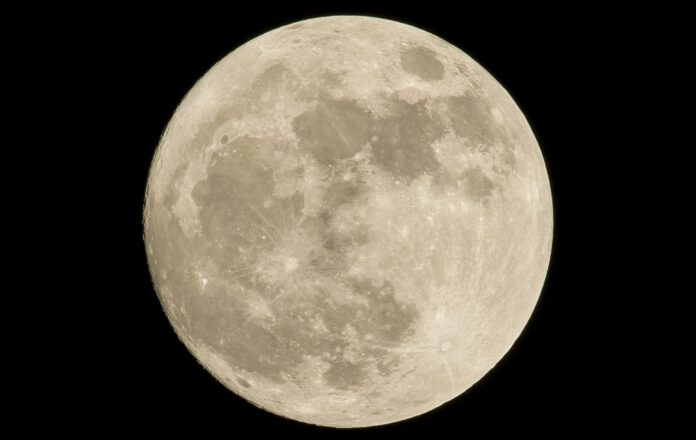
Approximately 4.5 billion years ago, a petite planet collided with the young Earth, sending fragments spiraling off into space. This debris gradually collected, cooled down, and shaped into a solid sphere – our Moon. Although scientists generally agree on this narrative, many of the finer details have remained an enigma – until now.
A large percentage of what we know about the Moon stems from samples of the lunar rock taken by Apollo astronauts over half a century ago, analyzed in combination with theoretical models. One peculiar detail emerged – these samples contained surprisingly high concentrations of titanium. However, subsequent satellite observations revealed that this type of rock only appears on the side of the Moon that faces the Earth. Astronomers have now started to understand how and why this is the case.
A Sea of Molten Magma
Due to its rapid formation and extreme heat, it is highly likely that the Moon was once coated in an ocean of magma. As this material slowly cooled and solidified, it formed the mantle and the bright crust that we can see when we gaze at the full moon at night. However, beneath the lunar surface, the young Moon was in complete imbalance. According to models, the last magma crystallized to form minerals like ilmenite, which contains titanium and iron.
“Since these heavy minerals have a higher density than the mantle underneath, an unstable gravity is created. You would anticipate this layer to sink deeper into the Moon’s core,” explains Weigang Liang, the lead researcher from the University of Arizona. Indeed, this did initially occur, but it mixed with the mantle, melted, and then re-surfaced as the titanium-rich lava flows that we can observe on the lunar surface today.
Inside Out
“Our moon literally turned itself inside out,” remarks researcher Jeff Andrews-Hanna, whose study appeared in Nature. “But we have very little physical evidence that sheds light on the exact sequence of events during this critical phase of lunar history, and there’s a great deal of debate concerning the details of what sank.”
Did this material sink as it formed, bit by bit, or did it all sink at once after the Moon had fully solidified? Did it sink all across the Moon and resurface on the front, or did it move to the front of the Moon and sink thereafter? Did it sink in one single glop, or in multiple smaller blobs? “Without evidence, your favorite model can be selected. However, each model has profound implications for the geological evolution of our Moon,” he adds.
The Titanium Layer
The researchers were guided by a former study from China. Their models suggested that the thick layer of titanium-rich material underneath the crust shifted to the front of the Moon first, possibly due to a massive impact on the opposite side. Afterward, it sank into the core of the Moon via a network of plateaus, somewhat like waterfalls. As the material sank, though, it left a trail of titanium just underneath the crust.
“When we saw the predictions of the model, it was like a light bulb was illuminated, because we could see the exact same pattern when we look at the subtle variations in the moon’s gravitational field. It uncovers a network of dense matter that hides under the crust,” Andrews-Hanna explains.
NASA Readings
In 2011 and 2012, two NASA spacecraft detected some small variations in gravity while orbiting the Moon. The researchers compared these readings with the simulation of the sinking ilmenite-rich layer, an exercise that revealed these anomalies circling a wide, dark area on the front of the moon covered in volcanic outflows.
The researchers found that NASA’s gravity readings were consistent with the simulations of the ilmenite layers and that the gravitational field could be exploited to map the distribution of the remnants of ilmenite, left behind after the majority had sunk.
A Consistent Tale
“Our analyses clearly show that the models and data tell a remarkably consistent story,” says Liang. “The ilmenite migrated to the front of the Moon and sunk into its core via cascading steps. In the process, it left a trail that led to variations in the Moon’s gravitational field, as observed by NASA.”
Not only do we now know more about what happened, but also when it transpired. The anomalies in the gravity ceased in step with the largest and oldest impact basins on the Moon’s front and must, therefore, have formed earlier. This suggests that the ilmenite-rich layer submerges more than 4.22 billion years ago, fitting into our understanding of how it contributed to later volcanic activity visible on the lunar surface.
“For the first time, we have physical evidence that reveals what was happening inside the Moon during a critical stage in its evolution, and that’s very exciting,” concludes Andrews-Hanna. “The earliest history of the Moon was written beneath its surface. All it took was the right combination of models and data to bring that story to light.”











